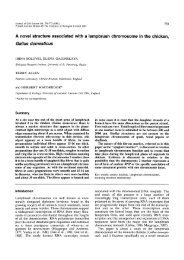European guidelines for youth AIDS peer education - University of ...
European guidelines for youth AIDS peer education - University of ...
European guidelines for youth AIDS peer education - University of ...
- No tags were found...
Create successful ePaper yourself
Turn your PDF publications into a flip-book with our unique Google optimized e-Paper software.
techniques, the presentation <strong>of</strong> lecture packages, talking in<strong>for</strong>mally to other young people about HIV, andthe use <strong>of</strong> various media are examples <strong>of</strong> useful training skills. In some projects with older young people, the<strong>peer</strong> educators initially develop increasing self-confidence, then concentrate on the developing their owncreative activities.HIV and risk behaviourThis covers specific skills in avoiding HIV infection. The training can cover decision-making and negotiatingsafer sex, pr<strong>of</strong>iciency in condom use, and the safe use <strong>of</strong> syringes. The <strong>peer</strong> educators should becomefamiliar with the various models <strong>of</strong> condoms available, and their specific uses. Training in condom useshould not just be technical and didactic, but instead encourage personal and effective responses. Thisallows the <strong>peer</strong> educators get over their embarrassment, and helps predict the responses <strong>of</strong> those they willbe instructing themselves.Communication skillsThe <strong>peer</strong> educators will eventually need to learn how to communicate messages to other young people, toper<strong>for</strong>m in front <strong>of</strong> groups, and to work with groups. This can require the ability to handle teasing, disorder,and intimate questions. Peer educators learn these skills through coaching from adults and feedback fromthe other <strong>peer</strong> educators. The project can invite specialists on drama, speech, media, and sex <strong>education</strong> tocontribute to the training.5 Support and sources <strong>of</strong> assistanceAfter the initial training, the <strong>peer</strong> educators will embark on a new learning experience and need support andassistance in developing activities and carrying them out. We recommend the use <strong>of</strong> small supervisiongroups that meet on a regular basis. These are facilitated by adults experienced in <strong>peer</strong> <strong>education</strong> or who arespecially trained in this role (<strong>for</strong> example, school staff). Peer educator self-development and relationshipswithin the project and with intermediaries need special attention.Other <strong>for</strong>ms <strong>of</strong> assistance can be made available. Where to find the kinds <strong>of</strong> expertise that, <strong>for</strong> example,local trainers, intermediaries and medical pr<strong>of</strong>essionals can <strong>of</strong>fer, should be clearly explained to the <strong>peer</strong>educators. Support can also include supplementary training, use <strong>of</strong> localities, and local sponsorship.ImplementationIn this phase, the knowledge, skills and insights gained by the <strong>peer</strong> educators during training aretrans<strong>for</strong>med into activities. Exercises completed during their own training may be re-used or new andunique activities developed. Throughout the process, the <strong>peer</strong> educators will act as change agents duringtheir in<strong>for</strong>mal contacts with friends and <strong>peer</strong>s.What was planned during the beginning <strong>of</strong> the project might end up being unfeasible, and expectations willhave to change. This is part <strong>of</strong> the on-going adaptation process. However, implementations should neverloose site <strong>of</strong> HIV-prevention aims. Flexibility and negotiation are key and the project should evolve ratherthan be <strong>for</strong>ced.Implementation sub-approachesPresented below are examples <strong>for</strong> carrying out various implementation programmes using the fourdescriptive sub-approaches presented earlier. Otherwise, we refer the reader to local experience and thepublished literature.Pedagogical approachThis approach may be used on its own or to complement other programmes (i.e. sex <strong>education</strong>). It usuallytakes place in a <strong>for</strong>mal setting, using a combination <strong>of</strong> didactic presentations, videos, slide shows, question-34 <strong>European</strong> <strong>guidelines</strong> <strong>for</strong> <strong>youth</strong> <strong>AIDS</strong> <strong>peer</strong> <strong>education</strong>
















